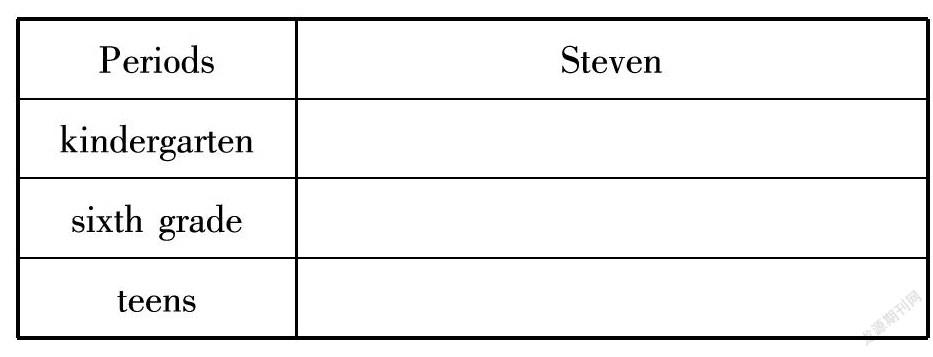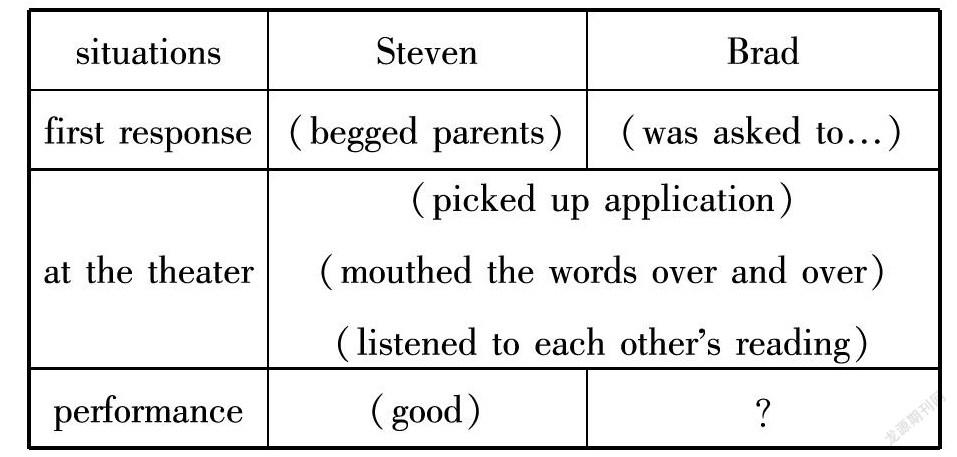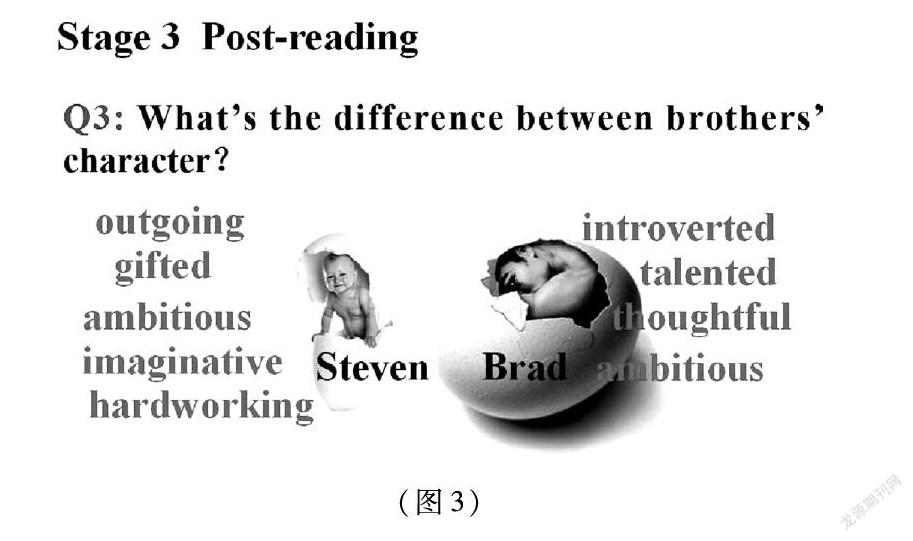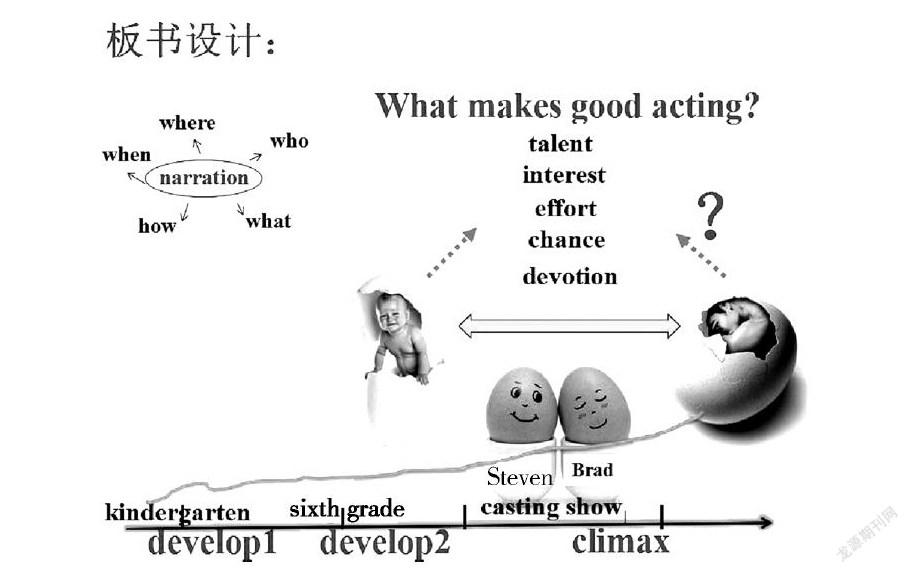基于主题意义探究的一节阅读课教学设计
闫玉芹






【课例背景】
此设计是河北省唐山市3E英语工作室组织的高一英语阅读课教学设计展示分享活动中的作品。在学习了《中学英语教师阅读教学研究丛书》(葛炳芳主编)之后,由工作室主持人田民老师给定文本(见附录),3E学员们进行了阅读课教学设计的实践。在展评过程中,本设计获得了学员们的高度赞扬和一致好评。课时用时40分钟。
【文本解讀】
阅读文本是一篇记叙文,以acting为主线,讲述了Steven和Brad参加表演秀的故事。人物形象对比鲜明,语言生动、富有寓意。写作方法独特,先抑后扬。文章的可读性和欣赏性很强。
【设计思路】
阅读课形式,侧重对文本的结构分析和作者写作手法的赏析。在题材的视角中,聚焦人物、情节、主题这一主线,在阅读过程中研究思考故事的发展、人物性格的对比以及探讨演员应具备的素质这一主题。
设计分为阅读前(Pre reading)、阅读中(While reading)和阅读后(Post reading)三部分:以著名演员的图片引出表演话题,自然过渡到文本阅读。进而对故事的情节发展和细节进行处理,对文本语言、人物描写和写作手法进行赏析。以故事的开端、发展、高潮和结局的挖掘为主线,以分析主人公的演员特质为次主线,引导学生在了解故事情节的过程中,感悟作者的写作手法。
同时,利用阅读任务的设置,培养学生在阅读时运用合适的阅读微技能:迅速掌握文章脉络,定位查找信息等。在设计时,从信息地查找到激发学生思维的过渡,注重课堂环节的循序渐进,环环相扣,还有串联整节课的主线和次主线,做到首尾呼应。
【教学过程】
Stage 1.Lead in (2m)
1.Who are they?
2.What makes good acting?
(设计说明)
利用幻灯片播放学生熟悉的中外著名演员图片,同时提出问题,让他们说出演员的名字或参演的影视剧名称,激发学生的学习兴趣,自然引入acting这一话题。对于第二个问题,进行头脑风暴,要求学生思考:哪些因素造就出色的表演?让学生集思广益,将学生的答案板书在黑板上,为后续的人物分析埋下伏笔。
Stage 2.
1.Fast reading (6m)
(1)What type of writing does the passage belong to?
①Exposition (说明文).
②Narration (记叙文).
③Argumentation (议论文).
(2)In what order does the story develop?
(3)Who are the main roles?
(4)What is the story about?
(设计说明)
以体裁和文章结构分析为侧重点。先对文体加以明确,弄清楚故事按时间顺序发展及主要人物的关系和故事的主线。引导学生有目的地阅读,迅速抓住文章的走向脉络,提高阅读的速度并体会略读的微技能。呈现简图(如图1),以探究文章的文体,为处理文章细节做准备。
板书突出文本的文体阅读方向,记叙文的写作要素:时间、地点、人物,事件。
用两个蛋壳代表故事的两个主人公,勾勒人物关系和故事发展的主线,为下一步阅读打下基础。同时为最后思维提升环节分析两个人物的性格特点埋下伏笔。
2.Detailed reading (20m)
(1) Steven's interest in acting
①Pick out the time points in the passage.
②Who is interested in acting, Steven or Brad?
③Descriptions about Steven's interest.
PeriodsSteven
kindergarten
sixth grade
teens
(设计说明)
此部分以“故事的开头、发展、高潮、结局”为主线。根据时间节点,引领学生定位查找有关Steven对表演有兴趣的描述,为下一个环节的语言处理做准备,同时为后面两个人物的对比分析做好铺垫。
Appreciate and analyze Steven's interest in acting.
a.He “drew” his name as it would appear on a marquee.(dream)
b.In his mind, he “practiced” his acceptance speech… (effort)
c.“… thank my agent…”, he imagined himself saying to the crowd.(devotion)
d.He was used to starring in school productions.(chance)
(设计说明)
分析有关Steven有表演兴趣的句子,同时引领学生进行语言处理。分析作者的巧妙用词,理解引号内双关语的作用, 突出人物的重点描写,进而提炼出Steven成为一个好演员所具备的各种品质,如心存梦想、不断努力练习、非常投入、有演出经历等。同时,对比文中没有描述Brad所具备的品质的部分,为结局中他的惊艳表现埋下伏笔,增加故事出其不意的效果。并且此部分与本课开始部分的引入环节巧妙相连,又为下个环节分析作者描写人物的对比手法提前进行了铺垫,做到了环节的巧妙过渡和衔接。
(2)About the casting show
situationsStevenBrad
first response(begged parents)(was asked to…)
at the theater(picked up application)
(mouthed the words over and over)
(listened to each other's reading)
performance(good)?
(设计说明)
此部分以“故事的开头、发展、高潮、结局”为主线。找出作者描述Steven和Brad在不同情境下的表现时所使用的语言,引领学生详细对比Steven和Brad对表演兴趣的描述,为之后分析作者描述人物的对比写作手法做好铺垫。
(3)The ending of the story
①Why couldn't Steven believe what he was seeing and hearing?
(Brad never showed his talent for acting.)
②What do Steven's words imply?
(Brad's reading was very good.)
(设计说明)
根据文本结尾Steven心理描写的语言化,分析Steven的话外之意。同时也是前面表格中确定Brad表现的答案来源。引领学生深度挖掘文本内涵,体会故事先抑后扬的写作风格。
Stage 3.Post reading (12m)
1.How does the plot develop in the passage?
(设计说明)
回顾故事情节的发展,进一步明确文本是按时间顺序描述以及故事的开端、发展、高潮和结局的框架(如图2)。同时, 对比分析Steven和Brad对acting的表现,以及出演的态度,引导学生更深刻地体会故事最后峰回路转的惊奇结局,为最后分析作者的写作手法做好铺垫。
Stage 3 Post-reading
1.How does the plot develop in the passage?
2.Discuss the following questions in groups:
Q1:From the story, do you think Brad would try out for the casting call in the end?
Q2:How did Brad get excellent acting, by accident, with talent or through effort?
(設计说明)
引发学生思考并合理想象故事下一步会如何发展。通过回答第二个问题,引导学生再次联系引入环节提出的好演员所具备的品质(interest, effort, chance, devotion, dream 等),联系Steven能出色表演的重要因素,为接下来分析作者的写作手法做铺垫。
回读第2段中有关Brad的语句“His brother said he was probably the first Romeo in the history of theater to have braces”和“Brad was not interested in acting”,再根据文章最后Steven的心理活动和话语,我们可以推知Brad非常有表演天赋。
Q3:What's the difference between brothers' character?
(设计说明)
通过前面对文体的认知和理解,在对人物描写已经相当熟悉的情况下,对人物性格进行分析,引领学生进行评判性思考。让学生跟随故事发展,通过作者的描述,了解兄弟两个对表演的不同表现及他们各自惊喜的结局,自然过渡升华到对人物性格的分析和作者的叙述风格的思考。
幻灯片展示答案(如图3)。破壳而出、可爱活泼的男孩代表Steven和躲在壳里、成熟内敛的Brad形成鲜明对比。该部分与第二环节中用两个蛋壳代表主人公相呼应。整个课堂水到渠成,首尾呼应。
此幻灯片与黑板上代表两个兄弟的蛋壳构成连续的画面,给人以震撼的视觉冲击。
Q4:How does the author describe the characters in this story?
Q5:How can we get a surprising ending?
(设计说明)
作者在弟弟对表演的兴趣上用很多语句形象描述,而对哥哥的描写很少。兄弟俩对表演的兴趣形成鲜明对比。然而,哥哥惊艳的表现让弟弟大吃一惊。作者采取了先抑后扬的写作手法,突出令人意想不到的神奇结局。故事情节戛然而止,让人意犹未尽,浮想联翩。
Assignment:
For all:Retell the story in your own words.
For some:Write what you have learned from the story , about description of characters or the writer's writing style.
(设计说明)
课外作业是课堂学习的深化、补充和延伸。不同层次的学生根据自己的水平自选作业,让每一个学生都有成就感。此部分的设计旨在帮助学生把所读内容、原有知识和阅读感想联系起来,使学生通过一定的语言输出进一步拓展和延伸对课文的理解,帮助他们熟悉目标语言,巩固所学知识。
【板书设计】
直观地展示本节课的阅读流程和两个课堂主线:其一,记叙文文体结构,按照时间顺序,故事的开头、发展、高潮、结局。其二,优秀演员所需的重要素质,两个主人公性格的对比。同时板书为分析作者的写作手法提供了有理有据的直观参照。
【设计反思】
此篇记叙文的文体欣赏视角,从信息处理到语言知识,再到人物性格分析和作者写作手法赏析等环节的设计,对文本的初构、解构、重构、创构,在很大程度上都受益于对《中学英语教师阅读教学研究丛书》(葛炳芳主编)的阅读和学习。
设计从文本的文体解读和作品赏析这一视角展开。故事依照时间顺序,开头、发展、高潮分别描述了各个阶段两位主人公对acting的不同表现,出其不意的结局更突出了人物性格的鲜明对比。所以笔者设置了两条线索串联课堂中的各个环节,即文体结构和人物分析,把读前、读中和读后三部分有机结合起来。
课堂主线清晰,课堂进程环环相扣。各个环节问题的设置,考虑到了学生的认知水平,由表象理解到人物性格和写作手法的深度思考,由浅入深,由局部到综合,层递设计。同时注重了问题的连贯性,逐层逐级铺设台阶。
以静为主的课堂氛围,给学生充足的时间阅读和思考。小组的讨论能促进学生积极发表自己的见解,形成活跃讨论的课堂氛围。有深度的课堂不是热闹的课堂,所以在教学实践中,教师需要掌控一静一闹的不同效果。
速读、查读、略读、赏读等阅读微技能在阅读问题或任务的引导下“润物细无声”。多种阅读策略和不同的活动方式在具体实施过程中都需要教师适当调整课堂节奏和气氛。阅读教学过程中有计划、有目的地渗透阅读技能,以提高学生的阅读效率以及整合文本信息的能力。
通读了全套阅读教学研究叢书,笔者对阅读教学较之前有了全新的认识,但还需进一步细读研习,才能真正领会丛书的精华。在今后的阅读教学实践中,笔者会不断地尝试摸索,拓展阅读,扩大自己的知识面,提高自身的文学修养和专业素养,逐渐把一些无意识的教学行为变成有意识的教学行为,让自己的阅读课有思想、有深度。学无止境,教无定法。学习、思考与实践同行,才能不断提高阅读课的教学质量。
附录
文本材料:
Steven had had his first starring role in kindergarten, playing a talking stone in a class play.From the moment that he heard the applause and took his bows, he knew he wanted to be an actor.
He “drew” his name as it would appear on a marquee.In his mind, he “practiced” his acceptance speech to the Academy Awards .“I want to thank my agent…” he imagined himself saying to the crowd.
By sixth grade, he was used to starring in school productions.He played Romeo in this year's Junior Shakespeare Festival.His brother said he was probably the first Romeo in the history of
theater to have braces.Steven liked everything about acting—except for his brother's comments about it.Brad was not interested in acting.
Steven dreamed of going to California or New York when he got older.Meanwhile, he read the “trades” at the library—the newspapers and magazines of the acting business.He couldn't believe it when he saw that there was going to be an open casting call in his own Midwestern city.He begged his parents to take him, but they worked on Saturdays and they couldn't take the day off.He was forced to ask his older brother, the critic.
The part called for a boy who looked about 14.Steven figured he could pass.Unlike Brad, Steven looked older than his age.Brad, on the other hand, at 16 looked more like 14.The boys arrived early at the theater where the try outs were taking place.There were already over 200 kids there.Steven picked up his application.Brad picked up one, too—“Just for fun,” he said.Each of them then studied the short script they'd been handed.Like all the other kids, they mouthed the words over and over.Some kids found quiet spaces to read their lines aloud , with all the right emotion.
Steven asked Brad to listen to his reading.“Okay, but you have to listen to mine, too.”
“Deal,” Steven answered.Then he read, and, as usual, he was good.Next, it was Brad's turn.Steven couldn't believe what he was seeing and hearing.Why hadn't Brad ever tried out for a play? Where had he gotten all this talent all of a sudden? He asked his brother , “Why haven't you tried before?”
“I was waiting for something big,” Brad replied.
参考文献
[1]中华人民共和国教育部.普通高中英语课程标准 (2017年版)[S].北京:人民教育出版社,2018.
[2]葛炳芳.中学英语教师阅读教学研究丛书[M].杭州:浙江大学出版社,2013.

